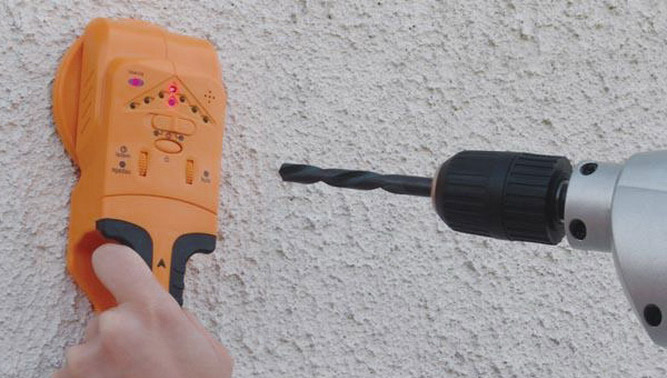How not to damage the wiring when working with a rotary hammer
Walls
With the walls, things are much easier, because Based on logic and generally accepted standards, it is possible to determine where the wiring goes, so that you can avoid getting into it with a punch. So, as a rule, the cable line runs parallel to the ceiling at a distance of 15 cm from it and goes down to electric points at a right angle, as shown in the photo below:
To avoid getting into the wiring when drilling is enough detect junction boxes in the walls (this can be done with the naked eye), which will show the exact height of the wires. After that, you need to look at where sockets, switches, and electrical panels are located. From all these points, the cable rises, so it’s better not to drill a wall above them, otherwise the chance of getting into the wiring will be almost 100%.
However, this method of cabling is not always found. In panel houses, wiring is laid in channels (cavities) in slabs. They, due to the design features of the plate and the requirements for its rigidity, run diagonally. An example of their location you see in the figure below.
If you are unable to determine the location of the electric line in the apartment or house using the described methods, it is better to use a special detector. There are inexpensive appliances for hidden wiring search. Their accuracy, of course, is not at the highest level, but with an error of 10-15 cm, you can find the wires in the wall, which will avoid getting into them with a drill.
If you just need hang the tv on the wall or to install a kitchen (meaning hanging cabinets), it is not advisable to buy a detector. In this case, we recommend do-it-yourself metal detector. A simple home-made device will also show the approximate location of the wiring.
You can also try using an indicator screwdriver to detect hidden wiring, but not the one with the neon lamp, but the one with the batteries and LED. If you take it by the sting and drive it with the back along the wall - it glows near the line, although this method is not too accurate. We also recommend tapping the wall around the proposed drilling site - this is the probability of “tapping” cavities and cable lines.
Ceiling
The desire not to touch the wiring when drilling the ceiling occurs most often during the installation of the chandelier. If a hook for hanging the lamp is not provided, but the wires are connected for connection, it is important to know the following in the first place:
- In prefabricated houses, most often cables over the ceiling are held in voids, so in order not to get into the wiring when drilling a plate, we recommend initially digging out a little place for the output of wires. So you will see where they are going, and you can retreat to a safe distance. The hole can later be plastered, in addition, the plate from the chandelier will hide all the defects.
- If the overlap is from a monolith, then, as a rule, the wiring to the chandelier is started vertically from the floor located above, so you need to step back a little from the withdrawn wires and drill a hole.
- In a private house, an electrician is carried out under the plaster, therefore, as in the first case, it is recommended to slightly open the floor and determine the direction in which the wiring passes.
In order not to get into the wiring when drilling the ceiling, you can also use a special detector, so if you doubt your strength or for some reason could not find the wire in the wall according to our advice, it is better to call a professional electrician. A wizard for a small fee from his own experience and with the help of a detector will do everything safely, and this is important.
Finally, we recommend watching a video in which the operation of the hidden wiring detector is clearly shown:
We hope that now you know how not to get into the wiring when drilling walls and ceilings with a perforator. Do not forget that you need to drill only when the voltage is off, and after creating the hole, you can turn on the machine and check if it works.
Related materials:










As a rule, the cable line runs parallel to the ceiling at a distance of 15 cm from it and goes down to electric points at a right angle.